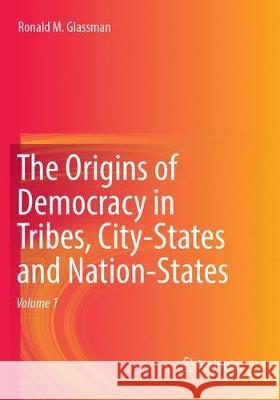The Origins of Democracy in Tribes, City-States and Nation-States » książka



The Origins of Democracy in Tribes, City-States and Nation-States
ISBN-13: 9783319847184 / Angielski / Miękka / 2018 / 1736 str.
The Origins of Democracy in Tribes, City-States and Nation-States
ISBN-13: 9783319847184 / Angielski / Miękka / 2018 / 1736 str.
(netto: 632,57 VAT: 5%)
Najniższa cena z 30 dni: 636,13
ok. 22 dni roboczych
Dostawa w 2026 r.
Darmowa dostawa!
Part I. The Emergence of Democracy in Bands and Tribes.- Chapter 1. Civilizations Peculiarities and Ideal Typicalities.- Chapter 3. Social Structure and Conflict Groups.- Chapter 4. Legitimation Process.- Chapter 5. Economy and Polity.- Chapter 6. Warfare and Religion.- Chapter 7. Chapter 7. Civilizational Peculiarities vs. Ideal Typicalities.- Chapter 8. Social Structure and Conflict Groups.- Chapter 9. The Political Institutions of Tribal societies: Kinship Democracy.- Chapter 10. Horticulture, Matri-Clans, and the Rise of the Status and Power of Women.- Chapter 11. Warfare and Politics.- Chapter 12. The Confederacy of Tribes: Representative Democracy Extended.- Chapter 13. Tribal Games.- Chapter 14. Religion and Politics in Tribal Society.- Chapter 15. Legitimation Processes in Tribal Society.- Chapter 16. Economy and Polity.- Chapter 17. Conclusions on Band and Tribal Societies.- Chapter 18. Civilization Peculiarities vs. Ideal Typicalities.- Chapter 19. Social Structure and Conflict Groups.- Chapter 20. Religion and Politics.- Chapter 21. Women and Politics in Horticultural Societies.- Chapter 22. Warfare in Horticultural Village Societies.- Chapter 23. Political Institutions: Theocratic Despotism.- Chapter 24. Legitimation Processes.- Chapter 25. Civilizational Peculiarities vs. Ideal Typicalities.- Chapter 26. Herding Tribes, Patri-Clans, and the Ride of the Military Kingship.- Chapter 27. Social Structure and Conflict Groups.- Chapter 28. Warfare, Women, Religion and Politics.- Chapter 29. The Political Institutions of Herding Society: Despotic Military Kingship.- Chapter 30. Military Kingship and State Violence.- Chapter 31. The Legitimacy Processes of Herding Societies.- Chapter 32. Economy and Polity.- Chapter 33. Some Impediments to Democracy in Horticultural and Herding Societies.- Chapter 34. Conclusions: The Paradox of Tribes.- Chapter 35. Introduction to the Middle Eastern Grain, Agricultural, and Animal Herding Societies.- Chapter 36. Democracy in the Sumerian City-States: The Assembly, the Elders, and the King.- Chapter 37. Projections of the Tribal Assembly in the World of the Sumerian Myths.- Chapter 38. The Status and Role of women in Ancient Sumer.- Chapter 39. The Temple Economy overseen by Priests and Priestesses.- Chapter 40. The Rise of the Kingship—Expansionary, Genocidal Warfare.- Chapter 41. From the Theocratic State to the Kingly-Bureaucratic State.- Chapter 42. The Reform Movements, the Ethic of Social Justice, and the Great Law Codes.- Chapter 43. The Pastoral Tribal Invasions and the Partial De-legitimation of the Kingship.- Chapter 44. The Expansion of the Merchant-Artisan Trading Sector of the Economy with the revival of Tribal Democracy and the Rise of Merchant Oligarchy.-Chapter 45. The Early Agricultural City-States of Canaan, Lebanon, and Syria.- Chapter 46. Ugarit—A Great Coastal Trading City.- Chapter 47. West Semitic Myths: The Ras Shamra Texts of Ugarit.- Chapter 48. Ebla—A Great Caravan City.- Chapter 49. The Political Structure of the Canaanite City-States: Monarchy and Merchant Oligarchy.- Chapter 50. From Canaanites to Phoenicians: A Tumultuous History of Conquest,
Ronald Glassman is a sociology professor at New York University located in New York, New York.
This four-part work describes and analyses democracy and despotism in tribes, city-states, and nation states. The theoretical framework used in this work combines Weberian, Aristotelian, evolutionary anthropological, and feminist theories in a comparative-historical context. The dual nature of humans, as both an animal and a consciously aware being, underpins the analysis presented.
Part One covers tribes. It uses anthropological literature to describe the “campfire democracy” of the African Bushmen, the Pygmies, and other band societies. Its main focus is on the tribal democracy of the Cheyenne, Iroquois, Huron, and other tribes, and it pays special attention to the role of women in tribal democracies. Part Two describes the city-states of Mesopotamia, Syria, and Canaan-Phoenicia, and includes a section on the theocracy of the Jews. This part focuses on the transition from tribal democracy to city-state democracy in the ancient Middle East – from the Sumerian city-states to the Phoenician. Part Three focuses on the origins of democracy and covers Greece—Mycenaean, Dorian, and the Golden Age. It presents a detailed description of the tribal democracy of Archaic Greece – emphasizing the causal effect of the hoplite-phalanx military formation in egalitarianizing Greek tribal society. Next, it analyses the transition from tribal to city-state democracy—with the new commercial classes engendering the oligarchic and democratic conflicts described by Plato and Aristotle. Part Four describes the Norse tribes as they contacted Rome, the rise of kingships, the renaissance of the city-states, and the parliamentary monarchies of the emerging nation-states. It provides details of the rise of commercial city states in Renaissance Italy, Hanseatic Germany and the Netherlands.
1997-2025 DolnySlask.com Agencja Internetowa
KrainaKsiazek.PL - Księgarnia Internetowa









